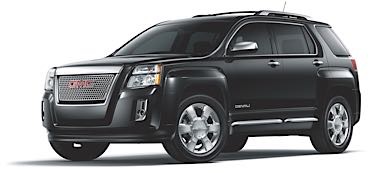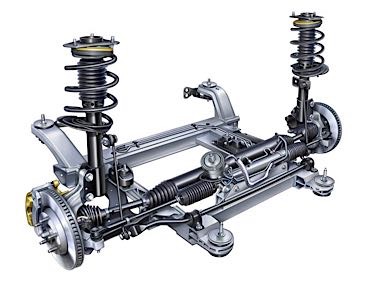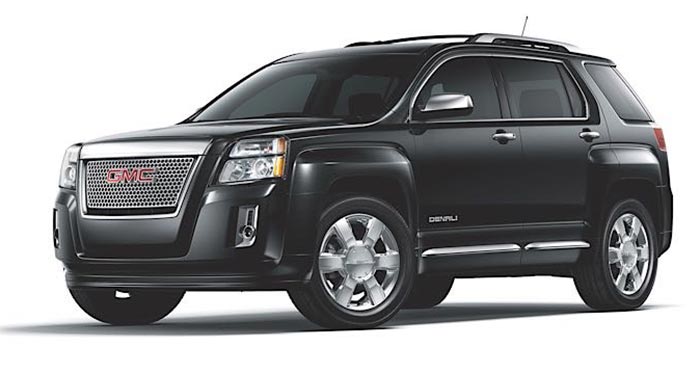 The Terrain rides on GM’s Theta platform and its alignment process is mechanically straightforward. The front suspension is a MacPherson strut design with hydraulic bushings in the lower control arms. The rear suspension is a four-link layout.
The Terrain rides on GM’s Theta platform and its alignment process is mechanically straightforward. The front suspension is a MacPherson strut design with hydraulic bushings in the lower control arms. The rear suspension is a four-link layout.
Front Suspension
To make a front camber adjustment, you must install cam bolts or elongate the mounting holes in the struts. Caster is not adjustable, but make sure you look at the cross caster angles to determine the condition of the control arm, bushings, and frame.
On older Terrain models in areas that see salt and rough roads, check the springs for broken coils. The front control arms use a rear bushing filled with hydraulic fluid. Chambers pass fluid at different rates depending on the movement of the suspension. When the bushing is working properly, it can be stiff under aggressive driving and gentle while traveling in a straight line.
Typically, hydraulic bushings do not leak; the damage is usually internal. Symptoms of a damaged bushing include rattle noise coming from the front of the vehicle while driving at slow speeds (approximately 5-10 mph) over rough road surfaces.
 Rear Suspension
Rear Suspension
The rear cams can have significant “cross talk,” so always recheck both angles after any adjustment of either cam.
To adjust rear camber:
• Loosen the upper control arm-to-frame fastener enough to allow movement. The frame of the vehicle is slotted, and turning the cam nut will move the camber in to the designated location.
• Rotate the upper control arm-to-frame fastener in the direction necessary to the correct the camber measurement.
• Snug the upper control arm-to-frame fastener. Do not tighten at this time.
• Re-inspect the rear camber specifications and adjust as necessary.
• Hold the nut and tighten the upper control arm-to-frame bolt to 121 lbs/ft.
• Repeat the procedure for the other rear wheel.
• To adjust the rear toe, loosen the cam bolt on the lower toe link enough to allow for movement.
• Rotate the suspension adjustment nut in the direction necessary to correct the toe angle.
• Snug the cam bolt. Do not tighten at this time.
• Re-inspect the rear toe specifications and adjust as necessary.
• Hold the nut and tighten the link-to-frame fastener bolt to 164 Nm (121 lb ft).
• Repeat the procedure for the other rear wheel.
Steering
You may get complaints from drivers that the steering is sticking or making noise at slow speed when the wheels are turned. The usual source of this complaint is the jounce bumpers and dust boots on the front struts. They do a great job of protecting the shaft and seals of the strut. But when they break or become unseated, it can result in noise. If the boots are damaged and the vehicle has high miles, recommend front strut replacement.
The Terrain is equipped with Electric Power Steering (EPS). During an alignment or other suspension service, it is important to remember that the steering position sensor needs to be re-calibrated afterwards. The system uses the power steering control module (PSCM), torque sensor, motor rotational sensor, motor, discrete battery voltage supply circuit, and the GMLAN serial data circuit to perform the system functions.
If any adjustments are made to either the front or rear toe angles, it is critical to re-calibrate the steering angle sensor. Failing to perform this procedure can damage the power steering module.
The PSCM will go into overload protection mode to avoid system thermal damage if the steering wheel is held in an off-center position for an extended period of time. The PSCM will limit the amount of current commanded to the EPS motor, which will reduce the power steering assist level. If the PSCM detects a high system temperature and the overload protection mode is initiated, DTC C0176 System Thermal Error may set.
On 2010-2014 models, GM has a campaign for “stick-slip” condition on models with electric power steering. The problem could cause the steering wheel to stick in the straight-ahead position after driving long distances on a straight highway. The steering wheel can be turned but it may require increased effort. The fix is to replace the steering gear and reprogram the steering control module.
The scan tool will guide you through the following procedure:
• Using the steering wheel, align the front wheels forward.
• Set the transmission in the PARK position.
• Install the scan tool into the OBD II connector.
• Turn the ignition switch ON, with the engine OFF.
• Select Chassis/EBCM control system Vehicle Stability Enhancement System (VSES), special function test, and Steering Position Sensor Calibration.
• Follow the scan tool directions to complete the automated centering procedure. This should include turning the steering wheel left 5º and right 5º and then straight forward.
• Clear any DTCs that may be set. Perform the Diagnostic System Check to verify no current DTCs.
• Test drive the vehicle.














